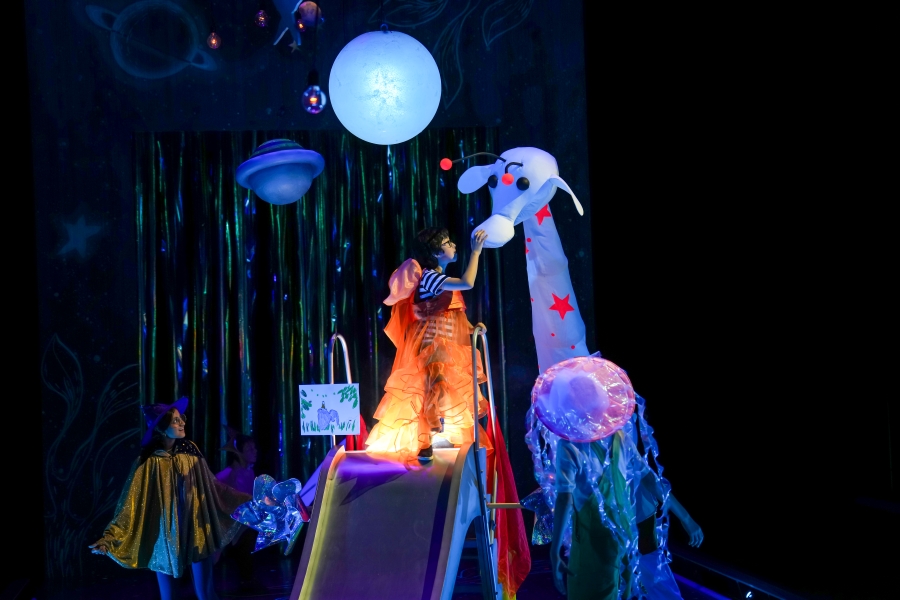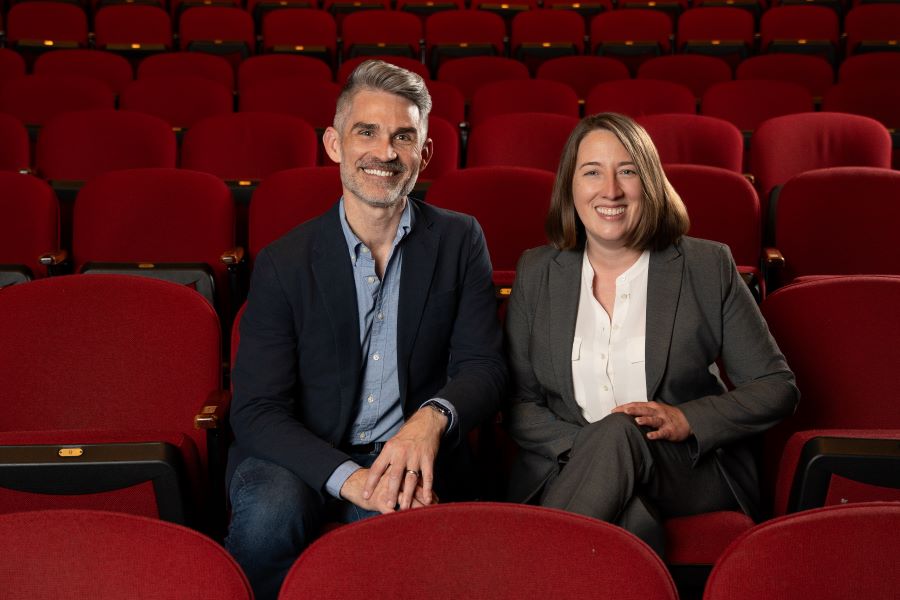“I think the most noble thing an artist can do right now is make something for a young person,” said new Children’s Theatre Company artistic director Rick Dildine.
Dildine, who most recently led the Alabama Shakespeare Festival, joined the Minneapolis company in July, succeeding longtime CTC leader Peter C. Brosius. The same month, he was joined by Jill A. Anderson, Syracuse Stage’s now-former managing director, who took over CTC’s managing director role as the theatre leadership musical chairs saw Kimberly Motes make her way to Chicago Shakespeare Theater.
When asking Dildine and Anderson what drew them to these roles, they both pushed beyond simply acknowledging CTC’s history of excellence. Having grown to become the nation’s largest theatre for young people, CTC has developed more than 200 new works, with two more world premieres slated for their 2024-25 season. The Tony-winning regional theatre’s production of A Year with Frog and Toad even made its way to Broadway back in 2003.
But aside from the obvious enthusiasm that comes with being able to lead a company with such a history, Dildine said he saw this moment as a chance to stop and consider: How does he want to spend his time and his artistic thinking? When he told his husband about the opportunity, Dildine said, his husband reminded him that “every time you make a play, a musical, you always start with saying, ‘How can I get a kid to fall in love with theatre?'”
Continued Dildine, “I really do approach almost everything I do from the lens of my 9-year-old self, which was an imaginative, creative boy running around farm fields in Arkansas. So that sense of imagination, creativity—this feels like the best place that I can be as a person and an artist right now.”
For Anderson’s part, the CTC appointment marks a homecoming of a sort. After eight years at Syracuse Stage, and nearly a decade as the Eugene O’Neill Theater Center general manager before that, she’s finally found her way back to the Midwest. Growing up a Wisconsinite who would eventually wind up going to school at the University of Minnesota, this isn’t even her first interaction with CTC.
“The true tale is that I was a telemarketer here at CTC,” Anderson recalled, “so my own familiarity with and admiration for the company began back when I was a young person starting out in town. It’s always been there as one of the companies I’ve most admired in the nation. What more compelling position could there be, especially for a Midwestern gal ready to come home?”
Last month, I spoke with Dildine and Anderson about what the next chapter may be for a thoroughly established children’s theatre, what they’re bringing with them as they take the reins of the organization, and the next challenges facing the theatre field. The following has been edited for length and clarity.

JERALD RAYMOND PIERCE: What’s been the biggest surprise for you, either about the company itself or about the community and artists around this company?
JILL ANDERSON: I’m not sure this should be a surprise, but this theatre has an incredible team. Something I’m really enjoying is not just that it’s a bunch of professionals who are really good at their job, but I’m really enjoying how much the staff here like each other, support each other, value each other, have fun together, and collaborate so well together. That has been an absolute joy to find upon our arrival.
RICK DILDINE: Hear, hear, absolutely. It is a rock star team of folks who don’t take the choices and the selection of work [for granted]—it’s not minimized, it’s rigorous. They are bought into this mission and this audience. I firmly believe we have the most important audience in America, which is young people and their community.
The thing that is most surprising—I’m not sure that it’s surprising, but it certainly resonated with me—is that this organization has a deep bench of projects in the pipeline. Major regional theatres are recognizing the importance of multi-generational programming, and when they’re looking for a partner, they’re calling us. That has been really exciting to see. I’m talking about the legacy institutions saying, “This is an important part of our programming and we want to partner with you on it. What are you making? What are you doing? How do we do this?”
As you think about what’s next, I’m curious how you both looked at the company when you came in, and how you’re evaluating what that next chapter should look like. What does that next chapter for CTC look like for the two of you?
RICK: I’m so incredibly grateful that the board brought us in within two weeks of each other. To be able to start together is really exciting. I’m not coming into Jill’s house, and she’s not coming into my house. We’re building it together, and that’s really special. We’re both in our first 90 days here, so there’s no big pronouncements, no big declarations. It’s all about listening and understanding. This is a place that is incredibly stable, well-supported, has a lot of ideas, and we are trying to build on that. What I’m interested in is, how do we take the mission and envision it in a way that we haven’t seen yet, find new ways of creating community within this theatre, keep this theatre as a place where real conversations happen that center young people?
I see us becoming the nation’s children’s theatre, a place that people travel from all over to bring their kids. When I was a kid, I think back to the things that changed my life, and it’s those memories. Memories matter. We have a huge responsibility. It’s asking for the best work of our lives for this audience. You can certainly expect new work to keep happening, where we’re originating original pieces that speak to every stage of a young person’s life. That’s one thing I’m particularly interested in. We’ve had a sweet spot of 5- to 12-year-olds, but there’s under 5 and then there’s your teen years.
JILL: The things that fall under my sphere of influence here really relate to and support what Rick just shared. It is an imperative for this organization that we continue to find ways to derive the revenue needed, whether it’s philanthropic or through ticket sales and that kind of thing, to keep the organization healthy and thriving so that we can innovate, so that we can grow our reach.
Also, as Rick said, recognizing that this is a destination theatre. We think of the summer festivals that way, but we don’t often think of a resident theatre like this in that way. So seeing this as a place people come and build into their vacation plans—how do we continue to blow open the doors? That’s the goal.
I feel like every time we go to a new job, we take some learning from where we were. I’m curious, what was the learning you’re taking from your last stop that you’re able to apply at this new role?
RICK: There’s two things that instantly come to mind: Everything doesn’t have to be done now and everything can’t be done now. We want to move very quickly, or I want to move very quickly, but I have learned the power of patience. You can go farther when you take the time to understand and learn. So everything can’t happen all at once.
And trust artists. I am continually amazed at artists when I go to them and say, “Here’s what I’m trying to do,” and trust the thing that they’re going to come up with. I lean on artists all the time, giving them parameters like, “Here’s what I’m trying to do with this community. Here’s the story I’m trying to tell.” Artists are the most resourceful, imaginative people on this planet.
JILL: I had the good fortune of starting my previous position in Syracuse at the same time as its new artistic director [Robert Hupp] as well. So I think a lot of my hopes and dreams for how Rick and I build our partnership, and how we come in as new leaders in an institution with a lot of veteran staff, trustees, and audience members, is really shaped by what was a very good partnership in onboarding at Syracuse, in which an organization has that chance to turn over both leaders at the same time. It gives us a different kind of opportunity to enter and be impactful, and to be listening together.

Can you talk to me a bit about the balance of entering together and creating your vision for the company with any expectations that may be coming from the board? What have those conversations been like?
JILL: I think there’s a combo. We have the luxury of coming into an institution that is healthy and strong, so we have that time to do that listening and building together. But secondly—this will sound silly—recognizing the board selected us, so if they had a vision that was way over here, they probably would’ve hired a different pair of leaders. Recognizing that we already, through the recruitment process, through the selection process, and through our first 90 days here on the job, were already forming that shared vocabulary so that as we’re moving, we’re moving together—that’s important to me.
RICK: I think you pick leaders of a theatre for two things: for their taste and their track record. The board looked at us and saw within us where they wanted to see the institution go.
As far as mine and Jill’s relationship, I always compare this co-leadership model to two things—that we are responsible for ambition and capacity. That’s how a theatre is constantly moving forward. The artistic director, typically, is the ambition, and the managing director is the capacity. It doesn’t mean that Jill’s not ambitious or that I’m not worried about capacity, but that is the yin and the yang of it. I was thrilled when Jill put herself forward for this opportunity and they were recruiting her for this job, because she’s a partner I can envision doing that with.
If you were to mentally put yourselves 10 years in the future, what do you hope the community is saying about the company?
JILL: I hope that it is that this organization is an increasingly large part of an increasingly large number of people’s lives, that we are woven even more into even more parts of the communities that make up this area, while welcoming folks from around the world and around the country to our doors.
RICK: I want people saying, “Our kids are taken care of there, our families are taken care of there. We’re in good hands when we go to CTC.” And that CTC is a place that always takes advantage of being different. How are we going to be different in this moment? I take a lot of responsibility for, how can we pack in the most theatre per square inch? I want to be a theatre that, when they leave, they have experienced something that’s a memory that they’re going to have for the rest of their lives. My first theatre experience, it still sits with me. I can still see it. I know who I was with, I can remember the taste of peppermints in my mouth and Scrooge flying around onstage. Memories matter, and I want to be a place that young people and their communities think about.
Zooming out from CTC, if you had to pick the one thing that the theatre field needs to deal with immediately, with the most urgency, what is that thing and how do you see the field dealing with that?
JILL: On my side of the aisle, I’m always going to go to the idea of identifying innovative ways to balance our budgets, whether it is some of the efforts that are happening on a national level to change our relationship as a sector with the federal government or continuing to really focus our work on philanthropy so that we’re not as reliant on ticket sales. But for those of us who are fortunate enough to have managed our Covid reserves in a way that’s helping us build toward that future, there’s some significant structural economic models that need to be solved by the field, and it’s a slightly different story at every theatre. Some of us will weather that storm a little longer, a little easier, but we have to face these structural challenges around the economics of producing theatre in those resident models.
RICK: I think one of the great struggles is that we have not told the story of not only the financial impact of the arts in this country, but also the fact that the arts are our greatest cultural export. It is a multi-billion-dollar industry that is not short on ideas, it’s short on funding, and we haven’t told that story to Congress, to the country, well enough for them to value the arts and theatre as a vital part of society. It is a multi-billion-dollar industry with hundreds of thousands of people who participate, millions who participate in the arts, and we haven’t told the story that leads to consistent funding. That is a quandary for me. We’re not short on ideas. It’s not an ideas problem for us; it’s funding.
Jerald Raymond Pierce (he/him) is the managing editor of American Theatre. jpierce@tcg.org


